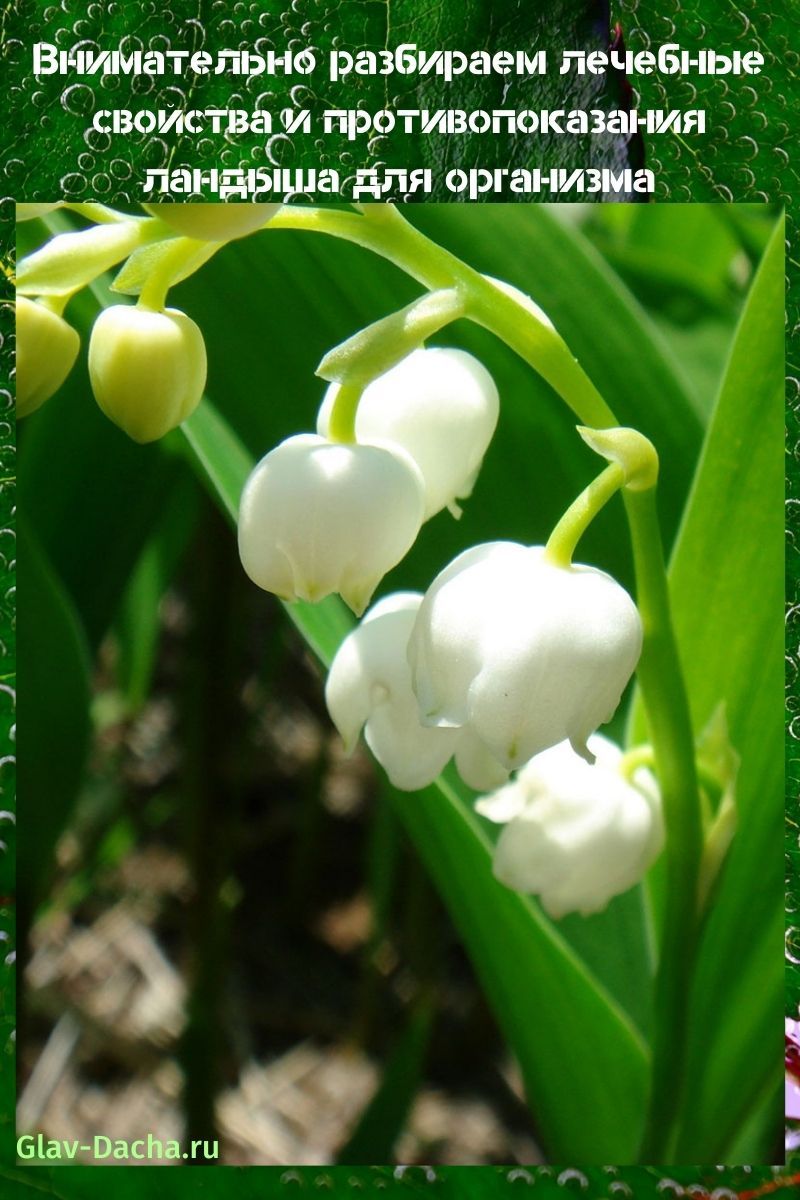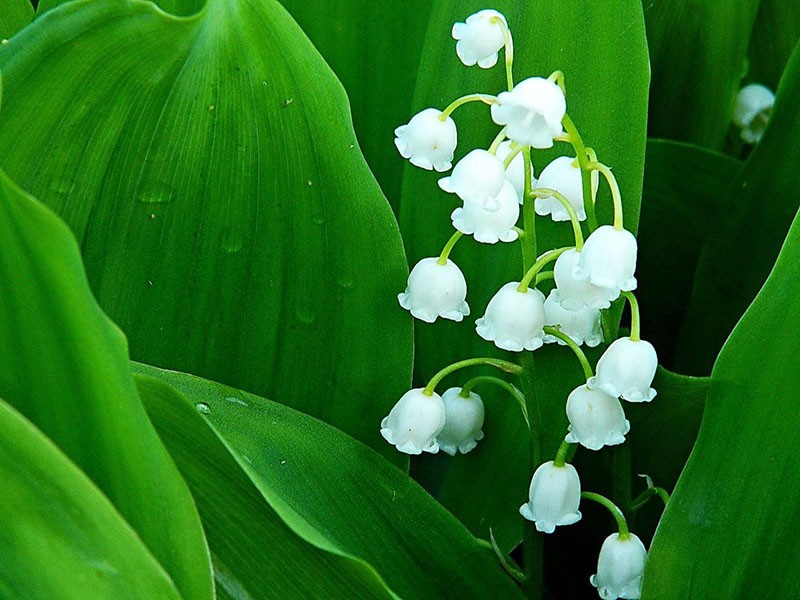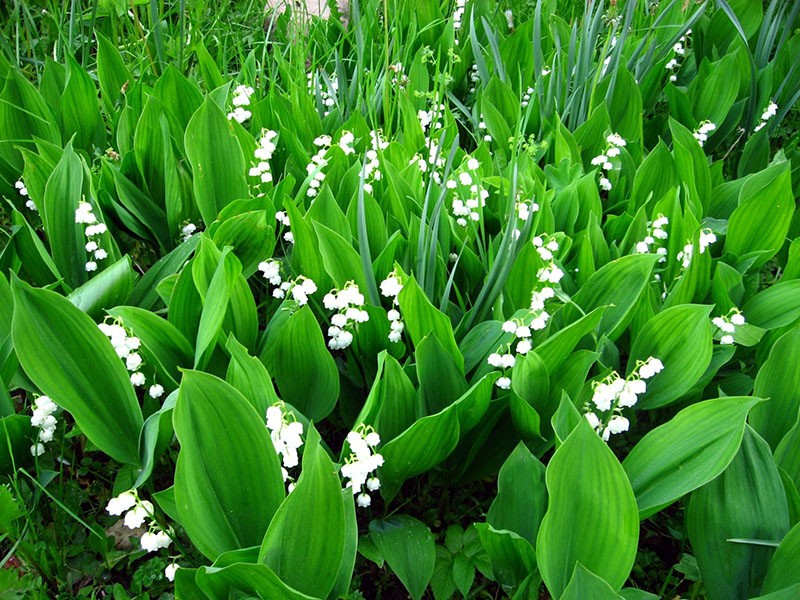We carefully analyze the medicinal properties and contraindications of lily of the valley for the body
 For centuries, true admirers of flora have tried to find a reliable "weapon" against ailments that cause suffering to people. Thanks to this, the medicinal properties and contraindications of lily of the valley for our health were discovered. After all, when snow-white bells bloom on graceful May flowers, the world becomes better. The air is filled with a heady aroma, and the earth puts on a green and white veil.
For centuries, true admirers of flora have tried to find a reliable "weapon" against ailments that cause suffering to people. Thanks to this, the medicinal properties and contraindications of lily of the valley for our health were discovered. After all, when snow-white bells bloom on graceful May flowers, the world becomes better. The air is filled with a heady aroma, and the earth puts on a green and white veil.
How do biologists describe this May flower? What "secrets" does he hide in the rhizome, foliage and inflorescences? For what diseases is it taken? How is lily of the valley used by humans in cosmetology? Let us turn to the specialists and find out the answers to the questions posed.
Exquisite gift of spring

 At the end of May, a graceful brush is formed on it, consisting of miniature bells of white or pinkish color. On one branch there are from 5 to 20 pieces.
At the end of May, a graceful brush is formed on it, consisting of miniature bells of white or pinkish color. On one branch there are from 5 to 20 pieces.
 After flowering, spherical red-orange berries appear on the culture. Inside there are round seeds that are waiting for their "finest hour" to turn into a beautiful flower. In their natural environment, lilies of the valley are found in Europe, Asia, North America and even Siberia. The plant chooses forest lawns, spacious meadows and wet shores near natural reservoirs.
After flowering, spherical red-orange berries appear on the culture. Inside there are round seeds that are waiting for their "finest hour" to turn into a beautiful flower. In their natural environment, lilies of the valley are found in Europe, Asia, North America and even Siberia. The plant chooses forest lawns, spacious meadows and wet shores near natural reservoirs.
Lilies of the valley are listed in the Red Book and are protected by law.
"The visible is temporary, and the invisible is eternal"
 It is no secret that whatever the flowers are, they dry up over time and cease to exist. However, the invisible components that are found in the buds and foliage of the plant remain in the ground forever. Let's consider the chemical composition of May lily of the valley provided by experts.
It is no secret that whatever the flowers are, they dry up over time and cease to exist. However, the invisible components that are found in the buds and foliage of the plant remain in the ground forever. Let's consider the chemical composition of May lily of the valley provided by experts.
Examining parts of a plant under a microscope, they saw a number of interesting compounds:
- vitamin C;
- citric and malic acids;
- essential oils;
- steroidal saponins;
- alkaloids;
- mineral compounds (selenium, zinc, nickel, cobalt);
- quercetin;
- starch;
- glycosides.
 The wide "assortment" of components indicates that the medicinal properties and contraindications of lily of the valley are closely related to each other. Therefore, traditional healers are advised to take medicine made from a flower with caution. Only small doses help to effectively fight ailments of various kinds.
The wide "assortment" of components indicates that the medicinal properties and contraindications of lily of the valley are closely related to each other. Therefore, traditional healers are advised to take medicine made from a flower with caution. Only small doses help to effectively fight ailments of various kinds.
Almost all parts of the culture contain toxic substances. Therefore, it is advisable to take decoctions and tinctures under the strict supervision of a specialist.
We use the medicinal properties and contraindications of lily of the valley for our own benefit

At the beginning of the 20th century, scientists isolated a healing extract from the May plant. Since then, it has been actively included in the composition of drugs that are prescribed for such diseases.:
- heart failure;
- neurosis;
- heart disease;
- hypertension.
 The medicinal properties of lily of the valley were also appreciated by traditional healers. In the spring, they diligently procure raw materials. First, the foliage is harvested (15 days before flowering), carefully cutting it off in the root zone. Then proceed to the buds.
The medicinal properties of lily of the valley were also appreciated by traditional healers. In the spring, they diligently procure raw materials. First, the foliage is harvested (15 days before flowering), carefully cutting it off in the root zone. Then proceed to the buds.
Since lily of the valley is listed in the Red Book, raw materials are harvested every 3 years.
It is dried in the traditional way. For medicinal purposes, decoctions and alcohol tincture are prepared. Let us analyze in more detail how lily of the valley is useful for a person, and for what ailments it is taken.
Underground culture
 People say that the fish rots from the head. Likewise, the plant starts from the root system.
People say that the fish rots from the head. Likewise, the plant starts from the root system.
It is she who is a storehouse of alkaloids and glycosides, which are used for treatment:
- muscle cramps;
- weakened blood vessels;
- cardiac disorders.
Healing potions are prepared from well-dried raw materials. The dry rhizome is first thoroughly crushed. Then pour boiling water. Insist 30 minutes. Strain through a tea strainer. It is taken as directed by the attending physician.
Doses are prescribed depending on the degree of the disease and the body's response to the components that the underground part of the plant contains.
Fleshy green flower
 According to research by scientists, the lily of the valley leaf contains a number of mineral compounds. They help the body fight germs that cause various ailments.
According to research by scientists, the lily of the valley leaf contains a number of mineral compounds. They help the body fight germs that cause various ailments.
A universal therapeutic "preparation" is prepared from sheet plates:
- lily of the valley;
- parsley;
- cocklebur.
All components are taken in about 50 g. Each of them is carefully crushed. Pour a glass of boiling water over. Cover with a tight lid and a towel. Withstand 15 minutes, then filter. Take 15 ml 3 times a day.
Aromatic drink from buds
 The use of lily of the valley flowers in folk medicine makes it possible to effectively fight migraines. Experts advise to grind the buds into powder. Put the mass on a flat saucer and inhale the healing aroma for several minutes. In addition, various decoctions and tinctures are made from dry raw materials. The drink is used to treat colds, disorders of the nervous system and malfunctions in the genitourinary system.
The use of lily of the valley flowers in folk medicine makes it possible to effectively fight migraines. Experts advise to grind the buds into powder. Put the mass on a flat saucer and inhale the healing aroma for several minutes. In addition, various decoctions and tinctures are made from dry raw materials. The drink is used to treat colds, disorders of the nervous system and malfunctions in the genitourinary system.
Consider a recipe for making a strong tincture of lily of the valley flowers:
- fresh buds are placed in a 0.5 liter jar by about a third;
- the raw material is poured with medical alcohol;
- close the container with a nylon lid;
- insist in a dark place for 14 days.
The liquid is shaken periodically. When the appointed time expires, filter the tincture through cheesecloth. Take drops of lily of the valley as directed by a doctor, depending on the diagnosis.
It is advisable to dilute the tincture of lily of the valley buds with clean water.
Attention, poisonous fruits!
 Small berries that form after flowering contain the glycoside convallatoxin. The substance is considered especially dangerous for the body and can lead to malfunction of vital systems. Once in the cell, the poison disrupts its ionic balance, causing severe intoxication in the body.
Small berries that form after flowering contain the glycoside convallatoxin. The substance is considered especially dangerous for the body and can lead to malfunction of vital systems. Once in the cell, the poison disrupts its ionic balance, causing severe intoxication in the body.
 What happens if you eat lily of the valley raw or dried? Experts note that only 4-5 bright "balls" of a fragrant plant can be fatal.
What happens if you eat lily of the valley raw or dried? Experts note that only 4-5 bright "balls" of a fragrant plant can be fatal.
The first signs of poisoning are such symptoms.:
- sharp pain in the abdominal cavity;
- nausea;
- dizziness;
- yellow complexion;
- arrhythmia.
If the fact is on the face, they immediately call an ambulance or the attending physician. In order not to waste precious time, the stomach is washed out. If necessary, an enema is done to cleanse the intestines. Therefore, lily of the valley berries are not used for the preparation of medicinal potions.
Lily of the valley and cosmetology
 Lush hair and a healthy complexion are the cherished dreams of almost all men and women. To achieve it, they use various means containing plant extracts. Especially valuable is the homemade lily of the valley decoction.
Lush hair and a healthy complexion are the cherished dreams of almost all men and women. To achieve it, they use various means containing plant extracts. Especially valuable is the homemade lily of the valley decoction.
It is made according to this scheme.:
- dry foliage of a flower (15 g) is poured with boiling water;
- simmer in a water bath for about 20-25 minutes;
- filter through a sieve.
The resulting liquid is used to wipe the skin of the face and rinse the curls after washing with shampoo.The amazing properties of lily of the valley and the use of a medicinal decoction strengthen hair, regulate the oiliness of the scalp and remove dandruff.
For the best effect, it is advisable to add a few drops of ready-made lily of the valley essential oil to shampoo or nourishing cream.
 Alcoholic inflorescence tincture is a wonderful remedy for fighting acne. It is prepared quite simply at home. Dry buds and leaf plates are ground into powder. Pour in vodka or rubbing alcohol. Leave for 15 days, then filter through cheesecloth. Use in place of skin cleansing lotion. Store in the refrigerator.
Alcoholic inflorescence tincture is a wonderful remedy for fighting acne. It is prepared quite simply at home. Dry buds and leaf plates are ground into powder. Pour in vodka or rubbing alcohol. Leave for 15 days, then filter through cheesecloth. Use in place of skin cleansing lotion. Store in the refrigerator.
The tincture is a wonderful remedy for joint treatment. It is used as an external rubbing of inflamed areas.
Caution for use
 Despite the widespread use of lily of the valley in medicine, there is a category of people who need to stay away from the plant.
Despite the widespread use of lily of the valley in medicine, there is a category of people who need to stay away from the plant.
It includes:
- pregnant women;
- nursing mothers;
- children under 18 years old.
In addition, drugs from the plant should not be taken for cardiosclerosis and chronic liver pathologies. And also during an exacerbation of gastrointestinal disorders. As you know, the rich smell of lily of the valley is harmful to allergy sufferers. It causes swelling of the airways. It often leads to headaches. It is better for such people to find another way to treat their ailments than to further aggravate their situation.
Lily of the valley bouquets should not be left in a poorly ventilated room.
 A detailed study of the beneficial properties and contraindications of lily of the valley makes us delighted. Despite the poisonous nature, flowers can be used to fight various ailments. Potions are prepared quite simply if a proven recipe is at hand. It is imperative that you seek the advice of your healthcare professional before use. Let us take our precious health seriously.
A detailed study of the beneficial properties and contraindications of lily of the valley makes us delighted. Despite the poisonous nature, flowers can be used to fight various ailments. Potions are prepared quite simply if a proven recipe is at hand. It is imperative that you seek the advice of your healthcare professional before use. Let us take our precious health seriously.